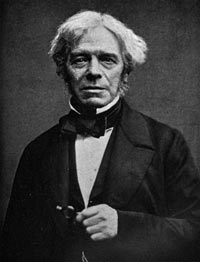
| Born: Sep 22, 1791 in Newington Butts, England |
| Died: Aug 25, 1867 (at age 75) in Hampton Court, Middlesex, England |
| Nationality: British |
| Famous For: Faraday’s law of induction, Electrochemistry, Faraday effect, Faraday cage, Faraday constant, Faraday cup, and other theories of physics |
| Awards: Royal Medal (1835 and 1846), Copley Medal (1832 and 1838) and Rumford Medal (1846) |
Michael Faraday was a renowned chemist and physicist who is widely known for his discovery of electromagnetic induction and the law of electrolysis. His major achievement in electricity was his creation of an electric motor.
Early Life
Faraday was born in 1791 in London to a poor family. He was a curious child who questioned everything. At the age of 14, Faraday started working at a bookseller and bookbinder on Blandford Street. He worked here for seven years and read many books. This made him want to implement the suggestions and principles the books contained. He also gained an interest in science, more specifically in electricity. He was inspired by Conversations of Chemistry, a book written by Jane Marcet.
Career Life
Faraday’s earliest science position was an assistant to Humphry Davy who was also a science enthusiast. Faraday was involved in the analysis of chlorine. He also carried out rough experiments on the diffusion of gases. He also created the early form of what is the now called the Bunsen burner. He worked comprehensively in chemistry; he discovered chemicals like benzene and discovered that chlorine could be turned into a liquid.
He was appointed the first ever Fullerian Professor in Chemistry in the year 1833. He started to work on electromagnetism, which is what he is best known for, in 1821. He created devices that produced electromagnetic rotations. These developments led to the invention of the electric motor. Ten years later, Michael perceived that passing of current through a copper wire coil that was wrapped around iron caused current to be induced in the adjacent coil. In this way, he invented the very first transformer.
In the second series of his creations, he was able to discover magneto-electric induction. This is the fabrication of a stable electric current. To achieve this, he joined two wires through the sliding of contact to a specific copper disc. He rotated the disc in between a horseshoe and poles and hence achieved a continuous current. With this he invented a generator.
Faraday continued in his electrical experiments. In 1832, he demonstrated that the voltaic electricity that is produced by batteries, static electricity and electricity that is induced by a magnetic have no difference. He did major works in electrochemistry discovering the First and Second Laws of Electrolysis. This was the basis for electrolysis. He also initiated two parts of scientific lectures in the Royal Institution: The Christmas lectures and Friday evening Discourses which still run to this day.
Personal Life
Michael Faraday was a staunch Sandemanian, a non-conformist sect of Protestantism. He met his wife through this church. Her name was Sarah Bernard and they later married in 1821. They bore no children. Michael Faraday retired to his home in Hampton Court in 1858. He died here aged 75 in 1867. He was buried in the section of dissenters in the High gate cemetery in London. He had refused to be buried in Westminster Abbey although there lays a memorial plaque dedicated to him near Isaac Newton‘s tomb.